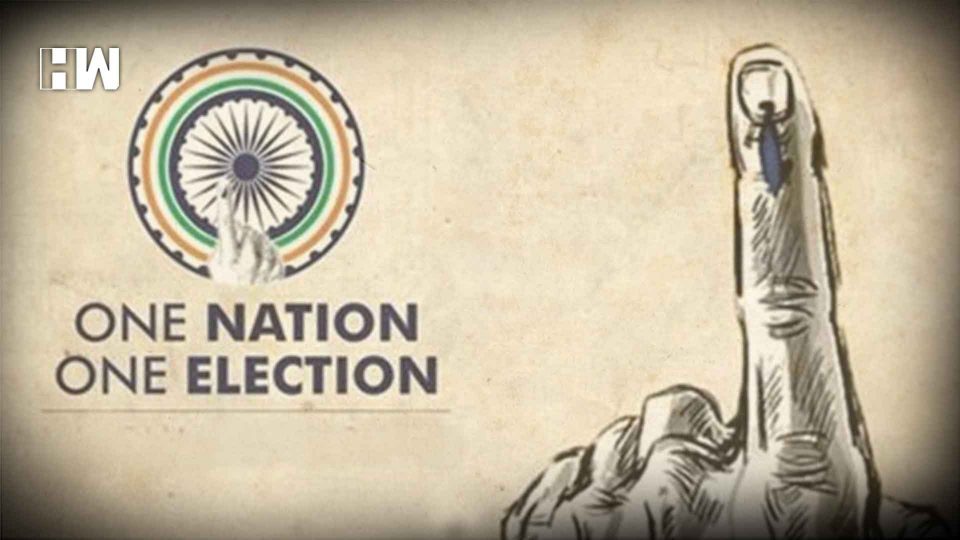To implement the complete idea of One Nation One Election a total of 5 amendments are required in the Indian Constitution.
Indian Democracy is the largest in the world, with more than 90 million voters. Elections have always played a major role.
Citizens above 18 years of age termed as voters elect their representative who raise their issue in the Constitutional Assemblies. With a federal structure in our nation, voters elect their representatives at various level – Local bodies, state assemblies to representatives at the Lok Sabha. These representatives are elected through a specific electoral procedure at a distinct period.
These separate elections give voters a chance to elect the representatives of their choice. However, this procedure makes a deep hole in the treasure of the nation. An estimate 60,000 crores were spent to conduct the 2019 Lok Sabha elections. With India having 29 states and 9 more Union Territories, we can only imagine the amount spent in the state-level elections.
With a thought to reduce the expenditure and make the electoral procedure cost-effective the Narendra Modi government has come up with a plan of One Nation One Elections.
What is One Nation One Election:
Similar to the term, One Nation One Elections means holding Lok Sabha, State Legislative Assemblies, Panchayats and Urban local bodies elections simultaneously once in every five years. Currently, the election for state assemblies, Local Bodies and Lok Sabha takes places on different occasions. For e.g in Maharashtra, Lok Sabha elections were conducted in April-May 2019, Assembly elections are scheduled for October 2019 while the Municipal elections for the city of Mumbai are scheduled for the year of 2022.
Why is One Nation One Election beneficial for India:
India is termed as the world largest democracy with 90 million voters and over 543 Lok Sabha seats and 4020 state assembly seats. Elections in India turn out to be a long, hectic and lengthy process. A lot of money, time and labour is been used to carry out these elections. And this occurs every 5 or 6 months in various states. So how could these elections be beneficial?
With simultaneous elections, the most beneficial thing for the country is that the cost and expenditure of the elections will be reduced. The possible plan of simultaneous election will reduce the impact of black money on voters which will indirectly curb corruption during the electoral process.
In the administrative point of view, the ruling government will be made to focus on the governance rather than being in the election mode. The governments can work for the implementation of policies and programmes rather than focusing on populist measures to woo the voters.
The simultaneous polls will also reject the idea of Model Code of Conduct (MCC) which comes into force with the announcement of poll dates, The MCC prevents the ruling government from announcing any new schemes, make any new appointments, transfers and postings without the approval of election commission. which brings the normal work of the government to a standstill.
Why is One Nation Once Elections difficult to implement in India:
With the political demographic so vast in a country such as India, the idea of One Nation One Elections look like an illusion and a daydream. Finding a political consensus in a country with 2293 political parties with 7 national and 49 states parties is like climbing the Mount Everest barefoot without oxygen.
Major opposition party- Congress chief Rahul Gandhi skipped the meeting of heads of the parties called by Prime Minister Narendra Modi to discuss the idea of One Nation One Election. The major opposition to this idea is from the regional parties in India who believe that the voters vote for the same parties when central and state election is held together. For e.g in 2014 and 2019 when assembly and state elections were held together in Andhra Pradesh and Odisha, voters voted for the same parties i.e in 2014 Andhra Pradesh Telegu Desam Party won a large number of seats in Assembly and Lok Sabha. Similarly in 2019 voters in Andhra Pradesh gave a similar verdict for YSR Congress in both state and Central.
The idea becomes more efficient as according to IDFC data, there is a 77% chance that the Indian voter will vote for the same party for both the state and Centre when elections are held simultaneously.
Constitution Amendment required for One Nation One Elections:
To implement the complete idea of One Nation One Elections a total of 5 amendments are required in the Indian Constitution. The article which need to be amended includes Article 83 which deals with the duration of Houses of Parliament, Article 172 which relates to the duration of state legislatures, Article 174 related to dissolution of state assemblies, Article 356 related to the President’s Rule and Article 85 which relates to the dissolution of Lok Sabha by the president.
Well, for now, the efforts of PM Modi to get consensus on One nation one election seem futile as major opposition party leaders have boycotted the meeting.
As an independent media platform, we do not take advertisements from governments and corporate houses. It is you, our readers, who have supported us on our journey to do honest and unbiased journalism. Please contribute, so that we can continue to do the same in future.

